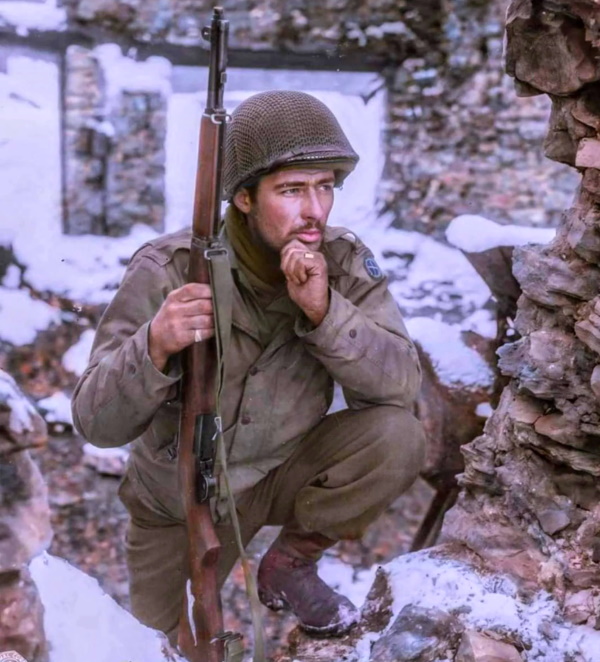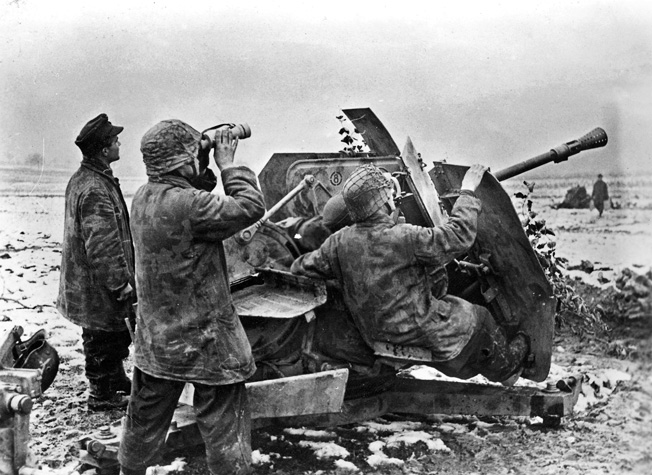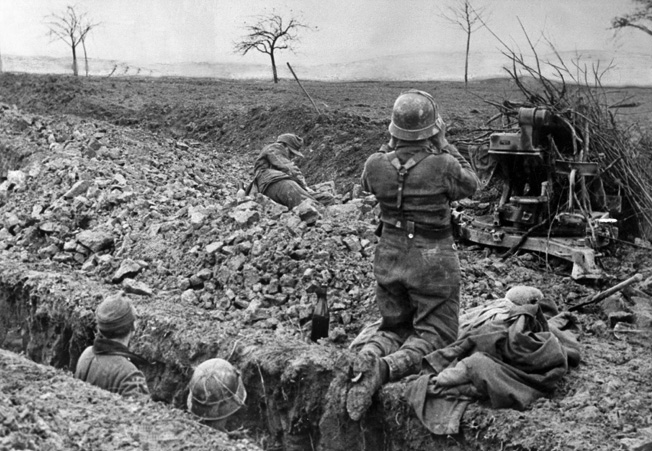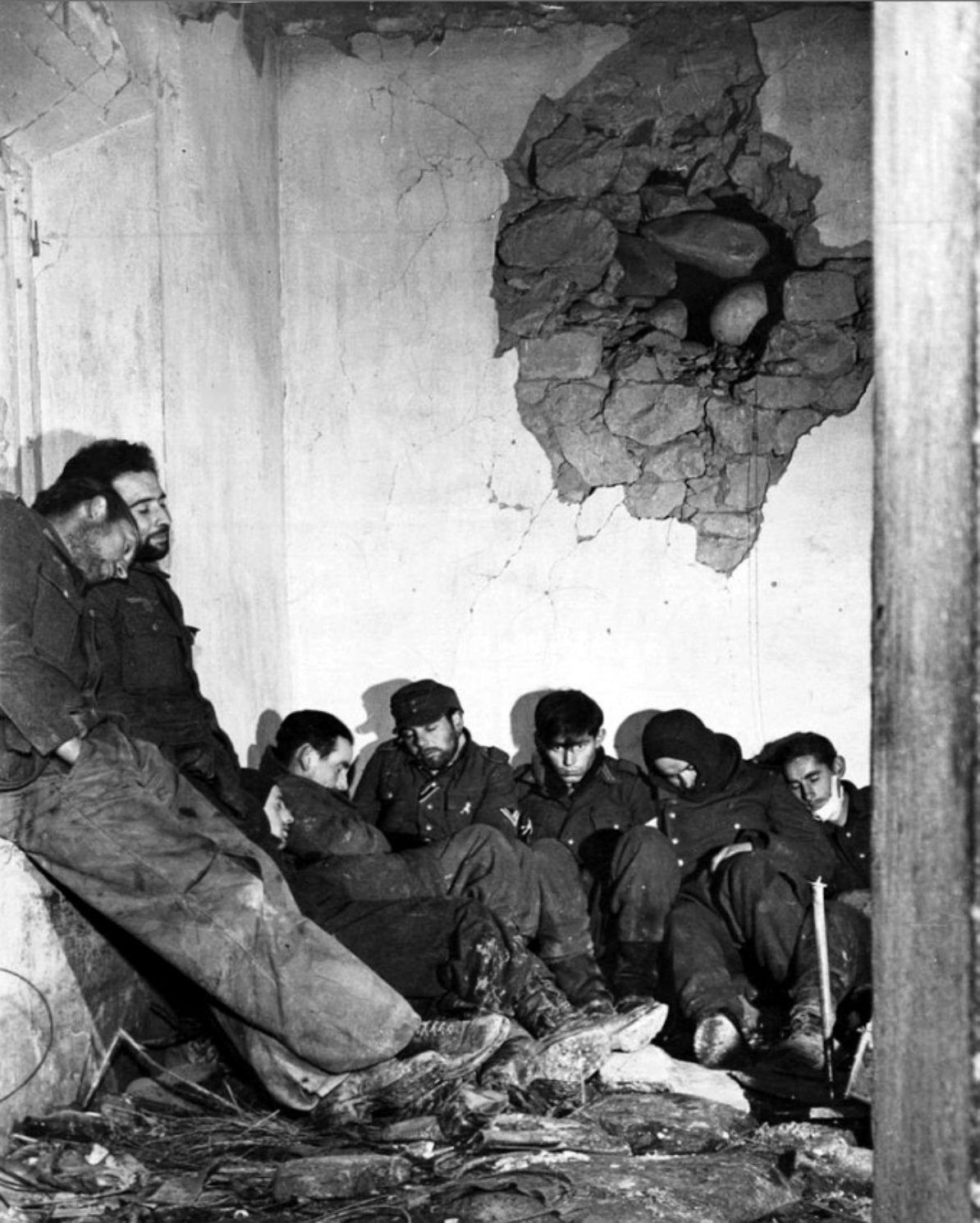At 0500, Dec 12, Baker and Charlie Cos, 1/134, crossed the Blies River in assault boats and moved into the town of Habkirchen, Germany. The two companies were the first infantry in the Division and XII Corps to occupy German soil with considerable force. However, members of the two companies were not the first individuals to set foot on German ground. Previously, at 0100 on Dec 12, a patrol of one officer and 3 enlisted men from King Co, 3/137, crossed the Blies River into Germany to recon landing sites on the east bank and returned. In Habkirchen, the enemy facing Baker and Charlie Cos was determined and stubborn and fought hard enough to prevent the companies from making any further progress. The 3/134, which was to cross the river on the left of the 1/134, was unable to do so because of the intense artillery and small arms fire. It remained in the vicinity of Blies – Ebersing. No gain was reported in the 137-IR zone. The 1/137 began its mission of protecting the division’s left flank by patrolling the Blies River where it runs south past Sarreguemines into the Sarre River and had its defenses tested by groups of the enemy who would move to the German border and fire across the Blies.
Against a hail of machine gun and tank fire, the 3/320, inched its way forward to the outskirts of the river town of Bliesbruck. Resistance was fierce and even with the aid of an airstrike by P-47 Thunderbolts, the battalion could not enter the town. In the left portion of the 320-IR sector, the 1/320 made preparations to cross the river at a point about 1000 Meters northwest of Bliesbruck. Assault companies protected the engineering equipment as it was brought forward to the river’s bank. The third counter-attack of the month directed against the division occurred at 0015 on Dec 13 and consisted of armored vehicles and infantry. The brunt of the attack was received by Baker and Charlie Cos 134. The attack threatened the companies’ positions in Habkirchen on the east bank of the Blies River. Although their lines bent, the riflemen fought back stubbornly and held their positions. Heavy fighting continued until 0400. During the early morning darkness of the day, the 35-ID began its offensive, which, if successful, would force the enemy in the division zone of advance to do all his fighting on his home ground. But first, a bridgehead over the Blies River, the last major obstacle before the Siegfried Line, had to be established.
Following a successful river crossing, the plan was for the 137-IR to seize the ground in the vicinity of Bliesransbach, the 134-IR the area in the vicinity of Wolfersheim, and the 320-IR had the limited objective of Nieder-Gallbach, and the area to the south of it. If successful, the drive would place the division at the gates of the Siegfried Line. At 0400 the attack moved off with Love Co and part of Item Co 134-IR, crossing the river and entering Habkirchen. There they joined forces with Able Co of the 1/134 which had previously crossed the river and at 0843 repulsed a counter-attack in the town. The remainder of the day was spent in holding the town and in getting the remaining elements of the 3/134 across the river.
The 2/134, in regimental reserve, moved to Blies-Ebersing. Also jumping off to cross the river at 0400, the 137-IR succeeded in crossing elements of the 3/137 just north of Habkirchen. Extremely heavy fire from the entrenched enemy on dominating ground to the north prevented any other elements from crossing and those across from movement. The 1/137 continued the mission of protecting the division’s left flank. This flank protection was necessary because the enemy still held the salient bordered on the west by the Sarre River and on the east by the Blies River that sticks out like a peninsula at, and north of Sarreguemines.
Attacking an hour earlier than the rest of the division (at 0300), the 1/320, crossed the river and attacked the strategic Hill 312, northwest of Bliesbruck. Against comparatively light resistance, it reached the hill by the close of daylight. From this ground, the battalion commanded the area as far north as Reinheim. The 3/320, during the morning, smashed the enemy-filled houses in Bliesbruck with the support of tank destroyers from the 654-TDB and Charlie Co, of the 737-TB, but made only small gains. However, by afternoon, it cleared a portion of the town. Stiff resistance continued. The 2/320 remained in the regimental reserve. Heavy fire from enemy-held high ground north of the Blies River continued to slow the progress of the division on Dec 14. The 2/134, crossed the river at 0400 in the 320-IR zone and advanced to the area about 1000 Meters northeast of Blies – Ebersing.
 Clearing Habkirchen house by house, the 1/134 and the 3/134 pushed further into the town. All front-line troops of the 134-IR were now in Germany. The 3/137 moved its remaining elements across the river and engaged the enemy in Habkirchen with the elements of the 134-IR. At 1000 it drove toward the regiment’s first objective. At 0500, the 2/320 moved out of the regimental reserve to attack north in conjunction with the 347-IR (87-ID) and reached positions about 1000 Meters west of Bliesbruck. The 1/320 remained on Hill 312 but dispatched Able Co to clear the remaining enemy from Bliesbruck while the 3/320 attacked north and reached positions about 1000 Meters north of Bliesbruck. The division and reinforcing artillery played a vital role in the establishment of the bridgehead across the Blies and the drive into Germany. Firing numerous TOTs (Time on Target), harassing, and interdiction fires, the artillery had a devastating effect on the enemy and was responsible for breaking up several counter-attacks. The effect of the artillery on the enemy is well brought out by the statements of prisoners of war taken in this action, as reported by division IPW teams. This is what three of the prisoners said.
Clearing Habkirchen house by house, the 1/134 and the 3/134 pushed further into the town. All front-line troops of the 134-IR were now in Germany. The 3/137 moved its remaining elements across the river and engaged the enemy in Habkirchen with the elements of the 134-IR. At 1000 it drove toward the regiment’s first objective. At 0500, the 2/320 moved out of the regimental reserve to attack north in conjunction with the 347-IR (87-ID) and reached positions about 1000 Meters west of Bliesbruck. The 1/320 remained on Hill 312 but dispatched Able Co to clear the remaining enemy from Bliesbruck while the 3/320 attacked north and reached positions about 1000 Meters north of Bliesbruck. The division and reinforcing artillery played a vital role in the establishment of the bridgehead across the Blies and the drive into Germany. Firing numerous TOTs (Time on Target), harassing, and interdiction fires, the artillery had a devastating effect on the enemy and was responsible for breaking up several counter-attacks. The effect of the artillery on the enemy is well brought out by the statements of prisoners of war taken in this action, as reported by division IPW teams. This is what three of the prisoners said.
POW #1 was a sergeant in the 9.Company of the 38.Regiment (17.SS-Panzergrenadier Division – Götz von Berlichingen) the battalion of which this PW was a member came into position on the high ground east of Habkirchen, two days before he was captured. His battalion received artillery fire, light, and medium caliber, after midnight on December 12. The artillery came in concentrations and as single rounds. The PW estimated there were at least 50% casualties in the battalion during the night. The artillery fire forced them to withdraw to the woods to the northeast. The next morning they were ordered to return to their original positions to prepare for a counterattack. There were to be reinforced for the counterattack with rear-echelon troops and others.
POW #2 was a Corporal in the 5.Company of the 165.Regiment (36.Infantry-Division – Wehrmacht) the battalion came to the area east of Habkirchen from Bolchen and to the Bolchen area from Forbach. The PW stated that the mission of the battalion was to blow the bridge at Habkirchen, destroy the bridgehead, and take up positions near the bridge site. Most of the artillery went over his company but landed on the units following. He said the artillery fire was very heavy and accurate and that it landed squarely in the lanes of attack.
POW #3 was a Lieutenant from the Grenadier Company, 165.Regiment (36.Infantry-Division) this PW was the Company Commander. He received an order to attack the American bridgehead at Habkirchen during the early morning hours of Dec 13. His company moved out and was caught in artillery fire at Bleismengen. It suffered some casualties there and the PW ordered his men to take cover in the cellars of the town. The attack continued from Bleismengen about 0500 – 0530 on the morning of Dec 14. His company again received artillery fire this time about 300 Meters north of Habkirchen along the road. It suffered a good many casualties and the attack was broken up. A portion of his company fled and the balance dispersed and were either killed or captured. This attack was to have been coordinated with an attack by the 17.SS-Division from the high ground to the east of Habkirchen. He said he asked for artillery support from the German artillery but it never came. He described the artillery as being very heavy and entirely too accurate. His information indicated that the American bridgehead was very lightly held, only four houses in Habkirchen were thought to be occupied.
The drive into Germany continued to be resisted stubbornly on Dec 15. The 1/134 and the 3/134 attacked the few remaining strong points in Habkirchen, announcing the town clear by noon. The 1/134 then became the regimental reserve and the 2/134 moved northwest and pushed into the Bannholz Forest by the end of the day. The 2/134 held its positions 1000 Meters northeast of Blies – Ebersing and patrolled the woods to the north. Meanwhile, the 1/137, continued to protect the division’s left flank and the 2/137, less George Co, remained in regimental reserve, the 3/137, with George Co attached, attacked the regiment’s 1st objective, reaching it early in the morning. The battalion continued north and entered the Brietenwald Forest, where it received a counter-attack consisting of 5 enemy tanks and 75 infantrymen. Driven from the south edge of the woods, the battalion fell back to positions south of Hill 330. Supported by artillery and tanks, the battalion counter-attacked immediately but was unable to re-enter the forest. Baker Co 737-TB was attached to the regiment in 1855.
 During the morning of Dec 15, the 1/320, had Able Co continue mopping up Bliesbruck on the north side of the Blies River while the remainder of the battalion drove on to an area west of Reinheim. The 2/320 overcame heavy resistance and seized Nieder-Gallbach during the afternoon. The 3/320 supported the attack on Reinheim. The push into Germany continued to make progress slowly. Resistance remained stiff and comparatively few prisoners were taken. On Dec 16, the 2/134 was attached to the 137-IR and went into position in the 137-IR zone. It then attacked with the 3/134, driving into the woods about 1000 Meters north of Reinheim. The 1/137, which had been protecting the division’s left flank, was relieved of this mission by the 2-CG (Cavalry Group) during the afternoon.
During the morning of Dec 15, the 1/320, had Able Co continue mopping up Bliesbruck on the north side of the Blies River while the remainder of the battalion drove on to an area west of Reinheim. The 2/320 overcame heavy resistance and seized Nieder-Gallbach during the afternoon. The 3/320 supported the attack on Reinheim. The push into Germany continued to make progress slowly. Resistance remained stiff and comparatively few prisoners were taken. On Dec 16, the 2/134 was attached to the 137-IR and went into position in the 137-IR zone. It then attacked with the 3/134, driving into the woods about 1000 Meters north of Reinheim. The 1/137, which had been protecting the division’s left flank, was relieved of this mission by the 2-CG (Cavalry Group) during the afternoon.
In the 320-IR sector, the 1/320 cleared Reinheim and moved to Hill 352 to maintain contact with the 3/320 on the right and the 2/134 on the left. The 2/320 and the 3/320 worked together to attack and seize Gersheim. The town, separated by the Blies River, was occupied in the east portion by the 2/320 and in the west by the 3/320. On the morning of December 17, the 35-ID attacked again. The 2/134 and the 3/134, continued clearing the woods north of Reinheim. During the afternoon, the 3/134 was relieved by the 1/137 and moved to an assembly area vicinity of Folpersviller for rest and reorganization. The 3/137 attempted assault after assault on the Breitenwald Forest but made little progress and suffered heavy casualties. During the night, the battalion was relieved by the 1/137. The 2/137 continued to clear the forest north of Reinheim. Attacking out of Gersheim into the factory area north of the town, the 2/320, seized the area, out-posted to the west, and made contact with the 347-IR (87-ID). The 1/320 encountered a farm nearly 1000 Meters west of Gersheim strongly and stubbornly defended by the enemy. By dark, however, the battalion had the farm surrounded on three sides. Elements of the 3/320 moved to the northwest to envelope the left of the enemy and assisted the 1/320.
On Dec 18, the 134-IR (less than one battalion) became the regimental reserve. The 1/134 was attached to the 137-IR and the 2/134 was relieved from attachment to the 137-IR. This relief was effected during the night of Dec 18-19. The 1/137, drove the enemy back into the Breitenwald Forest and reached the north edge of the woods. However, it continued fighting tanks, and infantry by-passed during the advance. During this time the 2/137 was attacking Bliesmengen meeting strong resistance. The 3/137 remained in the assembly area at Neunkirchen and continued to reorganize. The attack on the farmhouse by the 1/320, continued. After fighting all day, the battalion succeeded in taking the farm at 1500. The 3/320 remained at Gersheim but had elements assist the 1/320.
On Dec 19, the Division was ordered to hold and consolidate. The only major activity was in the area of the 1/137 which repelled several counter-attacks during the night of Dec 19-20. During the morning of Dec 20, the 1/134, received heavy counter-attacks by tanks and infantry and was pushed back to the south edge of the Reinheimwald Forest. While this was happening in the Division sector, the enemy launched a large-scale counter-offensive against the 1-A in the Belgian Ardennes. In order to be prepared to counter this blow with ready reserves, several divisions were pulled out of the line and dispatched to that area. The 35-ID was one of these and during the night of Dec 20-21, the relief of the division began.

 The 346/87-ID relieved the 320/35-ID in its zone. Late in the morning, the 137/35-ID was relieved by the 324/44-ID. The 134-IR, already in division reserve, moved back to its assembly area immediately. The division assembled in the vicinity of Ernstviller, Guebenhouse, Grundviller, Richeling, Remmering, Uberkinger, Holving, and Saint-Jean-Rohrbach. The 737-TB and the 654-TDB were detached from the division and sent into the fight in Belgium.
The 346/87-ID relieved the 320/35-ID in its zone. Late in the morning, the 137/35-ID was relieved by the 324/44-ID. The 134-IR, already in division reserve, moved back to its assembly area immediately. The division assembled in the vicinity of Ernstviller, Guebenhouse, Grundviller, Richeling, Remmering, Uberkinger, Holving, and Saint-Jean-Rohrbach. The 737-TB and the 654-TDB were detached from the division and sent into the fight in Belgium.
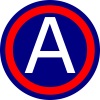 On Dec 22 and 23, the 35-ID moved to Metz where it was released from XII Corps and placed under direct control of the US 3-A. At Metz, the division was completely out of the line for the first time since it landed in France on Jul 7, 1944. On Christmas Day, the troops, billeted in warm buildings in the city, ate a hearty meal and were given passes into the town. On Dec 26, the 35-ID moved from Metz to the area north of Arlon, Belgium. Here it was to assist in Patton’s 3-A drive into the south flank of the enemy salient. For the operation, the 35-ID was placed under the control of III Corps while the 654-TDB was again attached to the 35-ID.
On Dec 22 and 23, the 35-ID moved to Metz where it was released from XII Corps and placed under direct control of the US 3-A. At Metz, the division was completely out of the line for the first time since it landed in France on Jul 7, 1944. On Christmas Day, the troops, billeted in warm buildings in the city, ate a hearty meal and were given passes into the town. On Dec 26, the 35-ID moved from Metz to the area north of Arlon, Belgium. Here it was to assist in Patton’s 3-A drive into the south flank of the enemy salient. For the operation, the 35-ID was placed under the control of III Corps while the 654-TDB was again attached to the 35-ID.

 On Dec 27, the division attacked north without recon from positions along the south bank of the Sûre River, with the 137-IR on the left, the 320-IR on the right, the 134-IR being in division reserve. The 4-AD was on the left and the 26-ID on the right. The attack moved off at 0800. The 137-IR moved by truck along a road in the 4-AD zone to a point southwest of Tintange, Belgium, in order to cross the river in friendly territory and made considerable gains until it reached Sûre. There it met bitter resistance and only after a hard struggle was it able to capture the town. The 320-IR experienced difficulty in crossing the river. Resistance from the north bank of the river was very strong but the 3/320, on the left, managed to wade elements across by noon. The 2/320 got a company across during the afternoon. Later the resistance lessened and by dark, the 2/320 was in Boulaide and Baschleiden, and the 3/320 was moving north. As the division moved up for the attack during the morning, it passed through and relieved the 6-CS (Cavalry Squadron) which had been holding in this sector.
On Dec 27, the division attacked north without recon from positions along the south bank of the Sûre River, with the 137-IR on the left, the 320-IR on the right, the 134-IR being in division reserve. The 4-AD was on the left and the 26-ID on the right. The attack moved off at 0800. The 137-IR moved by truck along a road in the 4-AD zone to a point southwest of Tintange, Belgium, in order to cross the river in friendly territory and made considerable gains until it reached Sûre. There it met bitter resistance and only after a hard struggle was it able to capture the town. The 320-IR experienced difficulty in crossing the river. Resistance from the north bank of the river was very strong but the 3/320, on the left, managed to wade elements across by noon. The 2/320 got a company across during the afternoon. Later the resistance lessened and by dark, the 2/320 was in Boulaide and Baschleiden, and the 3/320 was moving north. As the division moved up for the attack during the morning, it passed through and relieved the 6-CS (Cavalry Squadron) which had been holding in this sector.
At 0600, Dec 28, the 35-ID continued its drive against the south flank of the enemy salient. The 137-IR made only slight gains during the day. The 2/137 made a small gain to the north of Surré and the 3/137 drove to the hill southwest of Villers-La-Bonne-Eau where very heavy small arms, mortar, and artillery fire was encountered. The battalion’s attempts to enter the town were all repulsed. Then, to assist the 3/137, the 1/137 moved out of the regimental reserve and was committed to the left of the 3/137. In the 320-IR zone, the 0600 attacks also made a little gain. The 2/320 drove against considerable resistance to take the high ground about 1000 Meters northwest Baschleiden. The 3/320 continued its attack to the north and secured the four-road junction north of Baschleiden. The 1/320 remained in reserve in the vicinity of Boulaide. The 134-IR, in the division reserve, moved by motor to the vicinity of Warnach during the early morning. The 3/134 immediately went into action, relieving the 1/318-IR (80-ID), which had been attached to the 4-AD.
Dec 29, found the division again attacking. H-hour was 0800. The 1/137 and the 2/134, pushed to the north edge of the Sure Forest while the 3/137 made a little gain in its drive into Villers-La-Bonne-Eau. Meanwhile, the 2/320 was engaged in a bitter battle with the enemy around a farm southeast of Harlange. The attack of the 3/320 met equally stiff resistance south of Harlange and gained little ground. The 134-IR came out of the division reserve and attacked north and northeast. The 3/134, already committed, pushed toward Lutrebois and seized most of the town by dark. The 1/134 moved into Marvie, three kilometers southeast of Bastogne, where it made contact with elements of the 101-A/B in besieged Bastogne pocket. The 2/134 moved to fill the gap between the 3/134 and the 3/137.
The enemy on the morning of Dec 30, launched an extremely heavy counter-attack with tanks and infantry of the 167.Volksgrenadier and 1.SS-Panzer-Division against the 137-IR and 134-IR. King and Love Cos of the 137-IR, in the town of Villers-La-Bonne-Eau, were surrounded by enemy elements, and very heavy pressure was placed against the rest of the regiment. The 134-IR hit hard by this counter-attack, held its positions throughout the day. The 320-IR, missed by the counter-attack, jumped off at 0800 but met very strong resistance from Harlange and the farm southeast of the town. The counter-attack, which had the mission of cutting the Arlon – Bastogne highway (N-4), was repulsed. The infantry in repulsing it had much assistance from the air corps and artillery. The enemy was continually strafed and bombed and subjected to severely heavy artillery fire. On the last day of December, the Division’s attempts to attack met with little success. Attempts to relieve the situation of King and Love Co, 137-IR, failed and the companies were given up for the loss when it was learned from PWs that the companies had been destroyed or captured.
